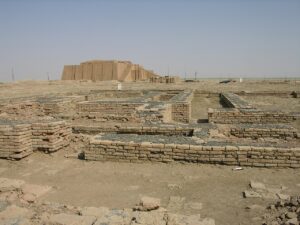
Ruins of Ur. By M.Lubinski from Iraq,USA. – Flickr, CC BY-SA 2.0, https://commons.wikimedia.org/w/index.php?curid=3065765
The ancient woodwork has perished, the metal has been stripped from the walls,” Sir Leonard Woolley wrote in 1936. “The ruins which excavation lays bare are but skeletons from which the skin and flesh have gone, and to re-create them in imagination we must use such evidence as the ruins may afford, eked out by descriptions in the cuneiform texts. A king will boast how he overlaid the doors of a sanctuary with gold, and amongst the ashes on the threshold of a temple gateway there may be found shreds of gold leaf overlooked by plunderers who sacked and burned the building; a fallen scrap of painted plaster can give a hint as to the adornment of a ceiling.”
The ruins of Ur are as lifeless today as Sir Leonard Woolley described them two years after his excavation of the site ended. But thanks to Woolley’s discoveries, we may conjure up a vivid picture of life at Ur. The British explorer uncovered not just scraps of plaster and shreds of gold, but entire vessels, headdresses and bull figurines made of the precious metal, ancient lyres, copper weapons and tools, silver bowls, a stunning assortment of jewelry made of imported lapis lazuli and carnelian, and more than 400 cylinder seals.
Read the rest of Abraham’s Ur: Did Woolley Excavate the Wrong Place? in the online Biblical Archaeology Society Library.